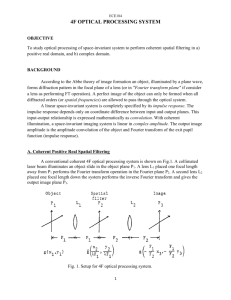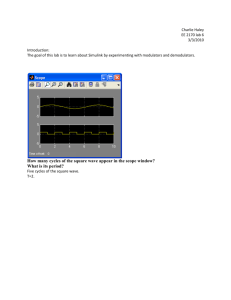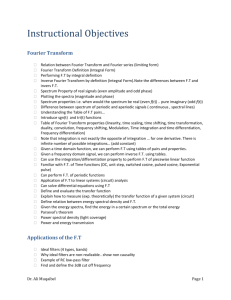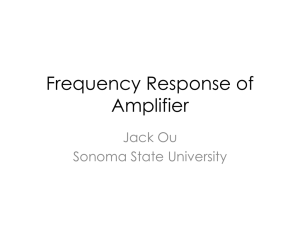LAB 1 - SIMPLE DIFFRACTION, FOURIER OPTICS AND ACOUSTO
advertisement
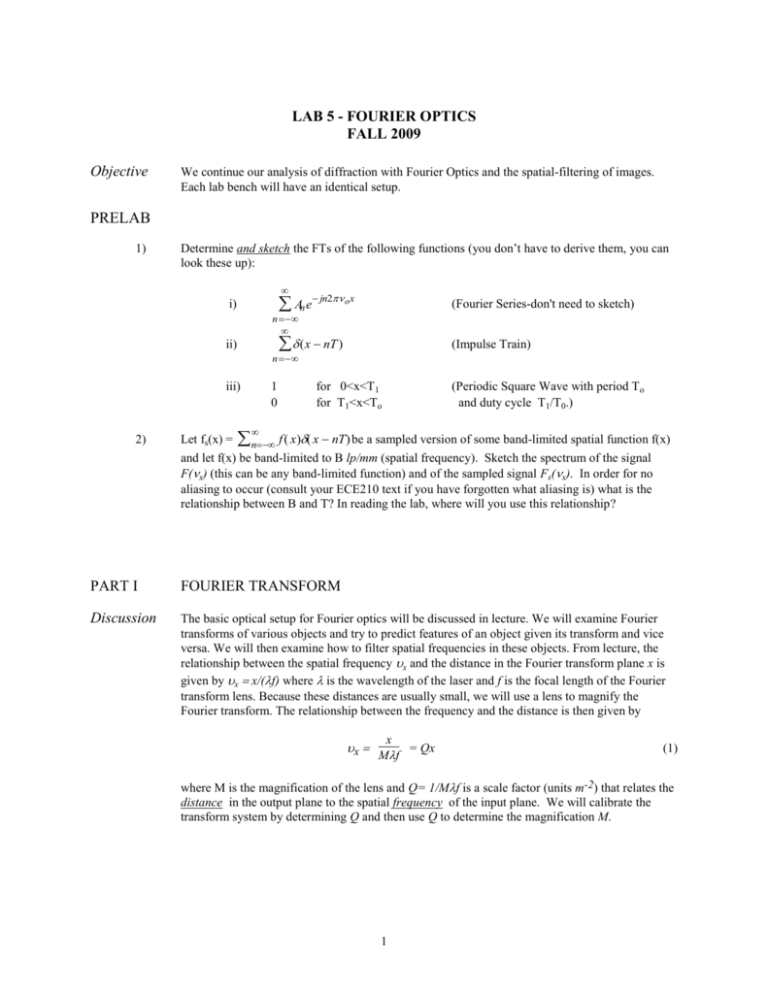
LAB 5 - FOURIER OPTICS FALL 2009 Objective We continue our analysis of diffraction with Fourier Optics and the spatial-filtering of images. Each lab bench will have an identical setup. PRELAB 1) Determine and sketch the FTs of the following functions (you don’t have to derive them, you can look these up): i) An e jn2 ox (Fourier Series-don't need to sketch) (x nT ) (Impulse Train) n ii) n iii) 2) Let fs(x) = 1 0 for 0<x<T1 for T1<x<To (Periodic Square Wave with period T o and duty cycle T1/T0.) n f ( x)( x nT) be a sampled version of some band-limited spatial function f(x) and let f(x) be band-limited to B lp/mm (spatial frequency). Sketch the spectrum of the signal F(x) (this can be any band-limited function) and of the sampled signal Fs(x). In order for no aliasing to occur (consult your ECE210 text if you have forgotten what aliasing is) what is the relationship between B and T? In reading the lab, where will you use this relationship? PART I FOURIER TRANSFORM Discussion The basic optical setup for Fourier optics will be discussed in lecture. We will examine Fourier transforms of various objects and try to predict features of an object given its transform and vice versa. We will then examine how to filter spatial frequencies in these objects. From lecture, the relationship between the spatial frequency x and the distance in the Fourier transform plane x is given by xx/(f) where is the wavelength of the laser and f is the focal length of the Fourier transform lens. Because these distances are usually small, we will use a lens to magnify the Fourier transform. The relationship between the frequency and the distance is then given by x x = Qx Mf (1) where M is the magnification of the lens and Q= 1/Mf is a scale factor (units m-2) that relates the distance in the output plane to the spatial frequency of the input plane. We will calibrate the transform system by determining Q and then use Q to determine the magnification M. 1 Calibration Discussion To clearly see the transforms of objects, we will have to magnify the transform plane and then calibrate the system using Eq. (1) to find the scaling factor Q. Spatial Filter Col. Lens Input Transform Lens Plane Viewing Screen Transform Plane A Laser ~70cm 10cm Magnifying Lens 50cm 1) A beam of collimated light will be available for you, up to the collimating lens. Place a slide holder at the input plane and place the Fourier transform lens (see Figure above) roughly 10 cm from the slide holder. The distances in the image are only meant as guides, and the lenses you select may have result in a different location for the transform plane. 2) Measure the approximate focal length of the magnifying lens and place it in position "A" shown on the figure to produce a real magnified image of the Fourier transform plane at the ruled sheet at the end of the table. Because of the calibration procedure, we do not need to determine the exact location of the Fourier transform plane to do the re-imaging. 3) Place the calibrated ruled grating (fundamental frequency 250 lines per inch ±1m or 10 line pairs per mm) at the input plane. The grating has a transmittance function of the following form Transmittance T1 Space To 4) Observe the spatial Fourier transform at the transform plane on the ruled paper. There should be a series of bright "dots". Now adjust the magnifying lens (A) so that these dots are magnified and in focus at the screen at the end of the table. Rotate the grating so that the "dots" of the Fourier transform are oriented along a line of the graph paper. These "dots" are the Fourier components of the periodic ruled grating. 2 5) Record the spacing between the dots. The frequency this distance represents is the fundamental frequency of the Fourier series (See Prelab). For the write-up, use the distance between the Fourier components and the fundamental frequency (10 line pairs per mm) to calculate the scaling factor Q from Eq.(1). From this scaling factor, calculate the magnification factor of the lens M. Compare this with the rough calculation of M = di/do where di is the image distance (lens to screen) and do is the object distance (from the transform plane to lens). Once you have calibrated the set-up, be careful not to move any part of it for the experiment. Experiment 1) Record the number of Fourier components until the first zero of the diffraction pattern (i.e. where no dot appears). Note that this may not be an integer value. For the write-up, calculate the ratio of T1/To for the ruled grating (see figure). This ratio is the grating's duty cycle. (Hint: use the results of last problem of Prelab Question 2.) 2) Place a different grid at the input (slide #2 or #14). Record the spacing between Fourier components, and the distance to the first zero. For the write-up, use the calibration factor Q and the distance between Fourier components in the transform plane to calculate the fundamental frequency. Assuming that the system is properly calibrated, what is the frequency of the slide? 3) Sketch the Fourier transform of the fine wire mesh (or slide #9) looking at the unmagnified transform plane - it will be where the dots are in focus for the first time. (The transform is too large if magnified.) Calculate the ratio of the wire size to the spacing between the wire (i.e. its duty cycle). Now translate the wire mesh in the input plane and observe what happens to transform. Explain. Rotate the mesh input and observe the transform. Explain for the write-up. 4) Observe and sketch the transform of slide #4 (spokes). This will be used for Part II. You may use a different input slide if you wish. 5) Examine the transform of the slide showing a picture of a geometrical object such as a letter (there won't be much to see). Now place both the slide of the object and fine wire mesh in the input plane. Sketch what you see and explain it for the write-up using the convolution property of Fourier transforms. PART II SPATIAL FILTERING Discussion A coherent optical system gives direct access to the Fourier transform plane where spatial filtering can be used. In this section, we will demonstrate some of the techniques involved. Alignment Procedure By adding an additional lens to the set-up from Part I, we can do spatial filtering. The set-up is shown below. 3 Sp atial Filter Inp ut Plane Transfo rm Lens Transfo rm Plane ReTransfo rm Lens Outpu t Screen Plane Laser M Locating the Transform Plane (this is a useful method for determining the focal length of a lens) Discussion To perform spatial filtering, we need to locate the exact position of the Fourier transform plane. To locate this plane, we note that the combination of the spatial filter and collimating lens produces an approximate plane wave. A second lens will focus this plane wave to a spot (the transform of a plane wave is a -function). We will use this idea to accurately determine the location of the transform plane. 1) Generate a beam of collimated light, if it is not already available. Roughly determine the focal length of the Fourier transform lens. 2) Now place a piece of diffuse glass in a slide holder, and place it one focal length from the lens. Place a screen behind the glass. There should be a small unfocused spot on the diffuser. The pattern on the screen is speckle. By moving the diffuser along the system axis, the pattern will become more or less "coarse". At the transform plane, the pattern is the coarsest and the spot size is a minimum (i.e. an approximate -function). Record the length to the diffuser and compare it with the rough estimate. Experiment 1) Place a good iris (one that can be stopped down to a small diameter), or a low-pass filter from the 'spatial filters' box in the Fourier transform plane and center it on the DC spot. (This spot will be bright so don’t look at it for long periods of time.) Place slide #4 (spokes), or another object of variable frequency, such as the 'picket fence' in the input plane. If you are using an iris, open it up and then gradually stop it down all the way. (Be careful, as the irises break easily.) The iris acts as a low pass filter and as you make the iris smaller, you are filtering more and more of the high spatial frequencies. If you are using the spatial filter slides, use filters of different bandwidths. Sketch and explain for the write-up what you see. 2) Repeat using a high pass filter on the same object. (Small black dot -the TA will provide this). Sketch and explain for the write-up. Try blocking higher-order frequencies. Explain what happens. 3) Repeat with a low pass slit filter at a variety of rotation angles. Explain for the write-up. 4) Take a clean microscope slide and place a fingerprint on it. Filter the image using the high pass filter. Explain for the write-up. 5) Place both the fine wire mesh and the picture of an object at the input plane, and place an good iris (low pass filter) at the transform plane centered on the DC spot. Open the iris and observe the 4 image. Now stop the iris down and explain what happens. With the iris small enough not to observe any "lines" in the image, move the iris to two other "spots" in the transform plane. Explain for the write-up what you see using the solution from Question 2 of Prelab. QUESTIONS/PROBLEMS FOR WRITE-UP 1) Suggest a method for optically computing the spatial derivative of a function. 2) How can laser light be used to compute the spatial convolution of two functions? 3) Which is a more accurate measurement, the duty cycle of the ruled grating, or the duty cycle of the wire mesh. Why? 4) In calculating the duty cycle of the wire screen or the calibration grating, how does one determine difference in the Fourier transforms between the following two patterns? Transmittance Transmittance Space Space Hint: Smaller aperture dimensions result in wider diffraction in the far field. 5
